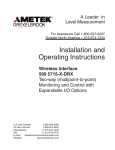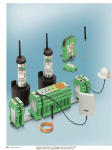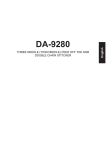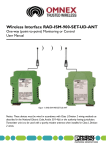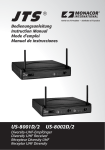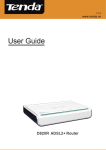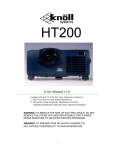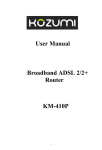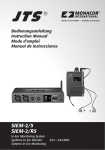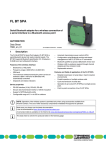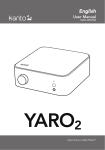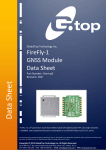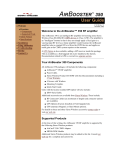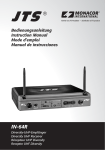Download PHOENIX CONTACT | Lose the Wires... Not the Signals
Transcript
Wireless Interface Products One-way Wireless System Module Grouping DIN mount Transmitter/Receiver set Conduit fit transmitter/DIN mount receiver Conduit fit transmitter/DIN mount receiver Product Description Type Description/ Order Number Datasheet/ CAD Manual Drawing One-way wireless system for Datasheet one 4-20mA and two discrete 24 signals. DIN rail mount Manual V dc 17.5mm wide integrated RAD-ISM-900-SET-UD-ANT radio with I/O. 2867102 One-way wireless system for one 4-20mA and two discrete signals. Weather proof 110(NEMA 4X) conduit mount RAD-ISM-900-SET-AC-UD 240 transmitter with DIN rail 2867021 V ac mount receiver. Accepts ac (110-240 V ac) line voltage inputs. One-way wireless system for one 4-20mA and two discrete 12- signals. Weather proof RAD-ISM-900-SET-DC-UD 30 (NEMA 4X) conduit mount 2867034 V dc transmitter with DIN rail mount receiver. Accepts ac (12-30 V dc) voltage inputs. Manual Manual DIN mount ReceiverSpare Spare receiver to be used as replacements or to duplicate 24 the receiving signals in oneV dc way point to multipoint applications RAD-ISM-900-RX 2867047 Datasheet Manual Two-way Wireless System (with expandable I/O options) Module Grouping Product Description [No image] ME BOS-KA (protective plugs for female side bus) ME B-SA/NS 35 (protective cover for male side bus) Integrated Radio with I/O Two-way radio transceiver set with 0ne 4-20mA in/out and two discrete signals in/out. 22.5mm wide with bus connection for power and communication. Does 9- not include antennas. 30 V Two-way radio transceiver dc set with 0ne 4-20mA in/out and two discrete signals in/out. Includes 1/4 wave whip antenna with 6' cable. 22.5mm wide with bus connection for power and communication. Type Description/ Order Number Datasheet/ CAD Manual Drawing ME BOS-KA 2854173 ME B-SA/NS 35 2935959 RAD-ISM-900-SET-BD-BUS 2867089 RAD-ISM-900-SET-BD-BUS-ANT 2867270 Datasheet Manual Datasheet Manual Repeater/Spare 930 V dc Device can be configured as a spare or as a repeater for long distance or heavily obstructed applications (requires HOPKEY for configuration) Transceiver/Repeater Device used to configure HOPKEY spare, repeaters or duplicates (requires ID number for original transceiver when used as a spare or in repeater configuration) RAD-ISM-900-BD-BUS 2867092 Manual RAD-ISM-900-HOP-US 2867539 Signal Duplication with Expandable I/O Module Grouping Product Description One-way signal duplicating 930 V dc Configured as a one-way system with one transmitter and two receivers. Multiple receivers can be added to extend duplication using MCR-RT-I/O repeater. Expandable I/O modules can be added to the transmitter and corresponding receivers. Type Description/ Order Number Datasheet/ CAD Manual Drawing RAD-ISM-900-1TX-2RX-BUS 2867571 Expandable I/O Module Grouping Product Description Type Description/ Datasheet/ CAD Order Number Manual Drawing 4-channel Analog Input Four channel analog input module (passive nonisolated 4-20mA input signals from 2-, 3-, 4-wire devices) RAD-IN-4A-I 2867115 Manual RAD-OUT-4A-I 2867128 Manual RAD-IN-8D 2867144 Manual 4-channel Analog Output Four channel analog isolated output module 8-channel Digital Input Eight channel digital input module (input voltage range 5-36 V ac/dc) 8-channel Digital Output Eight channel digital output module with relay outputs (120 V ac 5A rated contacts) RAD-OUT-8D-REL 2867157 Manual Return to Wireless Section ©2003PHOENIX CONTACT Phone: (800) 888-7388 Email: [email protected] Wireless I/O Interface Transmitter/Receiver Set RAD-ISM-900-...-UD Data Sheet 1483B August 2003 Features • 1 watt transmit power • Wireless conduit for one 4-20 mA and two digital signals • Interference free - Frequency Hopping Spread Spectrum technology • License free 902-928 MHz Industrial, Scientific and Medical (ISM) band • Easy to use, wire in – wire out, no setup or programming • Range: 600 – 1000 feet in-plant, no line-of-sight • Class I, Division 2 approved for hazardous area installation (UL, CUL and CSA approved) Applications • SCADA systems • Tank level • PLC/RTU extensions • Mills/quarries/factories • Pump control • Sensor monitoring • Water/wastewater • Utilities • Oil and gas • Irrigation systems Frequency Hopping Spread Spectrum Technology The Phoenix Contact RAD-ISM-900-...-UD is an integrated radio & I/O module designed to eliminate cable and conduit for one 4-20 mA current loop and two digital signals in harsh industrial environments. This unique addition to the Phoenix Contact signal conditioning line utilizes 902-928 MHz ISM band spread spectrum frequency hopping technology to guarantee a license free, interference free link between remote devices and the control room. Costly cable and conduit runs on new projects, or retrofitting of existing systems, are eliminated and replaced with a maintenance free, reliable and versatile wireless solution. • Petro-chem Benefits • Reduce cost of labor and installation • Eliminate conduit and wiring • Reliable and dependable operation Phoenix Contact Inc. • P.O. Box 4100 • Harrisburg, PA 17111 • Phone: (717) 944-1300 • Fax: (717) 944-1625 1 Wireless I/O Interface Transmitter/Receiver Set RAD-ISM-900-...-UD Ordering Information Table 1. Technical Specifications Part Description RAD-ISM-900-SET-UD System Part Number 28 67 10 2 Accessories Ordering Information Part Description MINI-PS-100-240AC/24DC/1 (universal voltage input 1 A, 24 Vdc power supply) Class I, Div. 2 Approved Power Supplies QUINT PS 120AC/24DC/1(1A,24VDC) Part Number 29 38 84 0 56 02 77 1 QUINT PS 120AC/24DC/2.5(2.5A,24VDC) 56 02 76 9 Headquarters, U.S. CM50-PS120/230/24DC/2.5IF 29 39 42 5 CM125-PS120/230/5IF 29 39 52 2 Class I, Div. 2 Approved Signal Converters MCR-T/UI-E (thermocouple or RTD to 4-20 mA converter) 28 14 11 3 MCR-C-UI/UI-DCI (converters for current to voltage or vice versa) 28 10 91 3 MCR-S1/5-UI-SW-DCI-NC (transducer for 0-11 A AC/DC) 28 14 73 1 MCR-S10/50-UI-SW-DCI-NC (current transducer for 0-55 A AC/DC) 28 14 74 4 MCR-F-UI-DC (frequency converter for 0-120 kHz) 28 14 60 5 Headquarters, Canada Phoenix Contact Ltd. 235 Watline Avenue Mississauga, Ontario L4Z 1P3 Phone: (905) 890-2820 Fax: (905) 890-0180 Phoenix Contact Inc. P.O. Box 4100 Harrisburg, PA 17111-0100 Technical Support and Information: (800) 322-3225 Fax: (717) 948-3475 Fax-On-Demand: (800) 944-9901 Email: [email protected] Web Site: http://www.phoenixcon.com The information given herein is based on data believed to be reliable, but Phoenix Contact Inc. makes no warranties expressed or implied as to the accuracy and assumes no liability arising out of its use by others. This publication is not to be taken as license to operate under, or recommendation to infringe, any patent. Data Sheet 1483B 2 Wireless Interface MCR-RT-I/O-PLUS... Two-way (Point-to-Point) Monitoring and Control with Expandable I/O Options Data Sheet 1655B February 2003 Ex p a n d a b l e Features • Modular DIN-rail mount transceiver and I/O • No programming required • Class I, Div. 2 approved • Up to eight (8) expandable I/O modules per transceiver on common power and communications bus with multiple combinations • Maximum thirty-three (33) analog or sixty-six (66) discrete signals in one direction • Dry contact LINK diagnostic output . . . Description The Phoenix Contact MCR-RT-I/O-PLUS is an integrated radio & I/O module designed for bi-directional interfacing of a 4-20mA current loop and two digital signals in harsh industrial environments. This unique design also allows the user the flexibility to add on multiple channels of I/O to the paired transceivers in combinations. The Frequency Hopping Spread Spectrum (FHSS) utilizes 902-928MHz ISM band to guarantee a license free, interference free link between remote devices and the control room. The design is ideal for moving numerous signals within high interference environments without costly cable and conduit runs. Typical Applications • SCADA systems • PLC/RTU extensions • Pump controls • Tank level/pressure/temperature monitoring • Water/wastewater • Petro-chem Phoenix Contact Inc. • P.O. Box 4100 • Harrisburg, PA 17111 • Phone: (717) 944-1300 • Fax: (717) 944-1625 1 Wireless Interface MCR-RT-I/O-PLUS... Two-way (Point-to-Point) Monitoring and Control with Expandable I/O Options Engineering Specifications Range ...................................................................600 to 1000 feet (180 to 305 m) in-plant [obstructed]; 4 to 5 miles ( 6 to 8 km) line-of-sight with Omni antenna; 20+ miles (32+ km) line-of-sight with Yagi antenna Inputs....................................................................One (1) 4-20 mA analog (16-bit resolution; 125 ohms impedance) Two (2) discrete (5 to 36 V dc) Outputs.................................................................One (1) 4-20 mA analog (16-bit rsolution; short-circuit protected) Two (2) discrete (dry contact, Normally Open (NO), contact rating: 250 V ac/5 A) I/O Expansion.......................................................Eight (8) analog and/or discrete I/O modules per transceiver station Accuracy ..............................................................Current loop: 0.2% of full-scale @ 77°F (25°C) Repeatability ........................................................Current loop: 0.02% Wiring Connections.............................................12-24 AWG screw-type terminals; removable terminal blocks Mounting ..............................................................DIN-rail mount Power (Input voltage) ..........................................9 to 30 V dc Power Consumption............................................75 mA at 24 V (average) 200 mA at 24 V (peak) Reverse Polarity Protection................................Yes Surge Protection..................................................Yes Temperature Rating.............................................-40°F to 158°F (-40°C to 70°C) Humidity ...............................................................20% to 90% (non-condensing) Dimensions ..........................................................4.5" x 3.9" x 0.9" (114 mm x 99 mm x 22.5 mm) LED Indicators .....................................................External (Power, RF Link, I/O Status) Unit ID ...................................................................Factory configured (unique); 16-bit coding of each transceiver pair allows multiple units to be used in the same area (easy configuration of spares with HopKey) Frequency ............................................................902 to 928 MHz - license-free ISM band Transmit Power ....................................................1 Watt (30dBm) Antenna Connector .............................................MCX (female) Environmental Rating..........................................NEMA 1 (equivalent to IP30) Approvals .............................................................USA - FCC Part 15.247 Canada - ISC RSS 210 Certifications .......................................................CSA/C & US UL - Class I, Div. 2 (Groups A, B, C ,D - pending) Specifications subject to change without notice MCR-RT-I/O-PLUS Components The MCR-RT-I/O-PLUS base system includes the following items: • Two MCR-RT-I/O-PLUS transceiver modules • Two 3” 1⁄4 wave whip antennas, each with 6’ of RG174 cable. The antennas can be mounted on an “L” bracket (also supplied) inside or outside a cabinet. Ordering Information Part Description Part Number MCR-RT-I/O-PLUS Transceiver set 5603378 MCR-RT-I/O-REPEATER 5603379 spare transceiver (can be used as repeater or in simplex mode for expansion) Expandable I/O options Part Description MCR-RT-4AI-DC MCR-RT-4AO-DC MCR-RT-8DI MCR-RT-8DO-REL Part Number 5603381 5603382 5603383 5603384 Phoenix Contact Inc. • P.O. Box 4100 • Harrisburg, PA 17111 • Phone: (717) 944-1300 • Fax: (717) 944-1625 2 Wireless Analog/Digital Link Transmitter/Receiver Set RAD-ISM-...-UD Installation Instructions 1473B August 2003 Features • Wireless conduit for one 4-20 mA and two digital signals • Range: 600 – 1000 feet in-plant, no line-of-sight • Easy to use, wire in – wire out, no setup or programming • Frequency Hopping Spread Spectrum technology (Interference free operation) • License free 902-928 MHz ISM band • 1 watt transmit power • 17.5 mm wide DIN-rail mount transmitter and receiver (Optional 120 Vac version for direct conduit mounting) Figure 1. Wireless Analog/Digital Link Transmitter/ Receiver Set RAD-ISM-900-...-UD The modules are available as a transmitter/receiver pair and come factory programmed, calibrated and tested as a set. Further switch configuration and programming are not required. Each set is given a unique address at the factory enabling multiple RADISM-900 systems to work independently in the same area without interference. The transmitter and receiver are powered separately by a 12-30 Vdc source (power supply, battery, solar etc). Quick and easy to install, the process signals are simply wired to the input terminals of the transmitter and output via wires connected to the receiver. No wiring is required in between. Typical in-plant range is 600 – 1,000 feet with no line-of-sight, much farther with outdoor applications. • Class I, Division 2 approved for hazardous area installation (UL, CUL and CSA approved) RAD-ISM-900-...-UD General Description The Phoenix Contact RAD-ISM-900-...-UD is an integrated radio & I/O module designed to eliminate cable and conduit for one 4-20 mA current loop and two digital signals in harsh industrial environments. This unique addition to the Phoenix Contact signal conditioning line utilizes 902-928 MHz ISM band spread spectrum frequency hopping technology to guarantee a license free, interference free link between remote devices and the control room. Costly cable and conduit runs on new projects, or retrofitting of existing systems, are eliminated and replaced with a maintenance free, reliable and versatile wireless solution. Common applications include monitoring/ control of pressure, level, temperature, flow, switching and alarms in situations where cable and conduit are either impossible or too costly to install, for example, retrieving pressure readings from a device on the other side of a railway track. Both the transmitter and receiver are DIN-rail mountable and with their dimensions of 102 mm (length) x 114.5 mm (height) x 17.5 mm (width) (4” x 4.5” x 0.7”) they offer a small wireless solution for every control cabinet. The RAD-ISM-900-...-UD provides LED indicators for digital input/output signal status at both radios and radio link status at receiver. Phoenix Contact Inc. • P.O. Box 4100 • Harrisburg, PA 17111 • Phone: (717) 944-1300 • Fax: (717) 944-1625 1 Wireless Analog/Digital Link Transmitter/Receiver Set RAD-ISM-900-...-UD As an option, weatherproof transmitters mounting directly to ½ inch NPT conduit are also available for AC or DC power sources. The RAD-ISM-900-...-UD transmitter and receiver pair is UL/CUL listed and approved for Class I, Division 2 installation. What is Frequency Hopping Spread Spectrum Technology? Prior to its introduction to Industrial, Scientific and Medical (ISM) use in 1987, this technology was used by the military for battlefield communications and weapons control due to its extreme tolerance of interference, and the difficulties it presented to those wishing to jam or intercept it. The key elements for the success of these radios are: a) their ability to frequency hop, b) their use of powerful narrowband signals (highest transmit power available under FCC guidelines), and c) their reliance on the redundant nature of the data being sent. Broadcasting within the 902-928 MHz band, RAD-ISM-900 radios transmit the status of their inputs on one frequency, then hop to transmit again on a different frequency. Hopping approximately every 20 milliseconds, the status of their inputs is updated 50 times per second in an interference free environment. In an industrial application, where interference is encountered from a variety of sources, EMI, motors, arc welders, etc., some hops will be affected. Anticipating interference the RAD-ISM-900 receivers’ error-check the data packet on every hop. When corrupted packets are received they discard the bad data and, hopping in synch with their transmitters, they look for the next clean update, which is then output. Since interference is encountered in most industrial applications it is assumed that all updates will not get through. Even so, if only 50 to 75% of the packets make it through unscathed this is more than adequate to update pressure, level, temperature, flow, ON/OFF and alarm. Figure 2. DIN-rail mounted units with antennas Figure 3. weather proof transmitter Two 3 ¼" wave whip antennas, each with 6’ of RG174 cable. The antennas can be mounted on an “L” bracket (also supplied) inside or outside a cabinet. For applications where a weatherproof housing is required for a field mounted transmitter two options are available: RAD-ISM-900-...-UD System Components 1) The RAD-ISM-900-TX-DC – a 12-30 Vdc NEMA 4X conduit mount (½” NPT) transmitter. The standard RAD-ISM-900-SET-UD system includes the following items (see Figure 1): 2) The RAD-ISM-900-TX-AC – a 110-240 Vac NEMA 4X conduit mount (½” NPT) transmitter that includes a 24 Vdc power supply for powering loop. One RAD-ISM-900-TX – a 12-30 Vdc DIN-rail mount transmitter (information available upon request) When either of these transmitters are chosen they are paired with an RAD-ISM-900-SET-UD 12-30 Vdc DINrail mount receiver. In this case, two different antennas are supplied, a 3” antenna mounting directly to the transmitter, and the standard 3 ¼" wave whip antenna with 6’ of RG174 cable for the receiver. One RAD-ISM-900-RX – a 12-30 Vdc DIN-rail mount receiver Phoenix Contact Inc. • P.O. Box 4100 • Harrisburg, PA 17111 • Phone: (717) 944-1300 • Fax: (717) 944-1625 Installation Instructions 1473B 2 Wireless Analog/Digital Link Transmitter/Receiver Set RAD-ISM-900-...-UD RAD-ISM-900 Transmitter Diagnostics Default Output Status As default the 4-20 mA analog signal on the receiver is designed to maintain last state. The default status of the two digital outputs is to also maintain last state. RAD-ISM-900-TX: • RF LED is solid green when unit is transmitting normally. For diagnostics and alarm purposes the RF link output can be used to drop the 4-20 mA to 0 mA if the analog output is wired through the RF link contact (or with an external relay) - this gives you 0 mA when the link is lost. The RF link relay can be used to turn ON/OFF one or both of the digital outputs by wiring them through the RF link contact (or an external relay connected to it) - this gives you options for the digital outputs when link is lost. • LEDs 1 and 2 show status of digital inputs 1 and 2. Solid green = ON. RAD-ISM-900-TX-DC: (optional weatherproof DC system) • Green LED on top of unit is solid green when unit is transmitting normally. • This unit does not have LEDs for digital inputs. RAD-ISM-900-TX-AC: (optional weatherproof AC system) • Green LED on top of unit is solid green when unit is transmitting normally. • This unit does not have LEDs for digital inputs. RAD-ISM-900-RX Receiver Diagnostics • The receiver features an RF link relay (alarm) that closes when RF link is established and locked with the transmitter. This provides solid indication (to PLC or other monitoring equipment) of the wireless link. • RF link LED blinks once every 2 seconds when receiver is ON but transmitter is either OFF, or out of range. • RF link LED continually blinks very rapidly when marginal signal is being received. This is an indication that one or both radios should have their antennas moved to an area where they will get better reception. • RF link LED blinks occasionally (random). This is an indication that interference is being encountered on some hops. This will not affect the performance of the radio and the installation should be considered successful. • RF LED is solid when an extremely secure link is established. • LEDs 1 and 2 show status of digital outputs 1 and 2. Solid green = ON. Phoenix Contact Inc. • P.O. Box 4100 • Harrisburg, PA 17111 • Phone: (717) 944-1300 • Fax: (717) 944-1625 3 Installation Instructions 1473B Wireless Analog/Digital Link Transmitter/Receiver Set RAD-ISM-900-...-UD Transmitter Wiring Diagrams Figure 4. 2 Wire Field device (4-20 mA) and 2 digital signals Figure 5. 3 Wire Field device (4-20 mA) and 2 digital signals Figure 6. 4 Wire Field device (4-20 mA) and 2 digital signals Phoenix Contact Inc. • P.O. Box 4100 • Harrisburg, PA 17111 • Phone: (717) 944-1300 • Fax: (717) 944-1625 Installation Instructions 1473B 4 Wireless Analog/Digital Link Transmitter/Receiver Set RAD-ISM-900-...-UD Receiver Wiring Diagram Figure 7. Receiver Wiring Diagram If used in a Class I, Div. 2 area, do not disconnect equipment unless power has been switched off or the area is known to be non-hazardous. Phoenix Contact Inc. • P.O. Box 4100 • Harrisburg, PA 17111 • Phone: (717) 944-1300 • Fax: (717) 944-1625 5 Installation Instructions1473B Wireless Analog/Digital Link Transmitter/Receiver Set RAD-ISM-900-...-UD Specifications Table 1. Technical Specifications Table 2. General Specifications Phoenix Contact Inc. • P.O. Box 4100 • Harrisburg, PA 17111 • Phone: (717) 944-1300 • Fax: (717) 944-1625 Installation Instructions 1473B 6 Wireless Analog/Digital Link Transmitter/Receiver Set RAD-ISM-900-...-UD Ordering Information Part Number Part Description RAD-ISM-900-SET-UD 28 67 10 2 RAD-ISM-900-RX (receiver only) 28 67 04 7 The Phoenix Contact control system RAD-ISM-900-...UD is a frequency hopping spread spectrum radio designed for professional installation and integration with other products. When installed with the provided antenna, the system integrator needs to make sure the RAD-ISM-900-...-UD’s FCC label, or a copy of that FCC label, is clearly visible on the RAD-ISM-900-...-UD is approved to operate within the 900 MHz ISM Band under Part 15 of the FCC Rules & Regulations. Optional AC and DC weatherproof transmitter systems RAD-ISM-900-SET-AC-UD 28 67 02 1 RAD-ISM-900-SET-DC-UD 28 67 03 4 Accessories Ordering Information FCC: This device complies with Part 15 of the FCC rules. Operation is subject to the following two conditions: Part Number Part Description MINI-PS-100-240AC/24DC/1 (universal voltage input 1 A, 24 Vdc power supply) Class I, Div. 2 Approved Power Supplies QUINT PS 120AC/24DC/1(1A,24VDC) 29 38 84 0 (1) This device may not cause harmful interference, and 56 02 77 1 QUINT PS 120AC/24DC/ 2.5(2.5A,24VDC) 56 02 76 9 CM50-PS120/230/24DC/2.5IF 29 39 42 5 CM125-PS120/230/5IF 29 39 52 2 Class I, Div. 2 Approved Signal Converters MCR-T/UI-E (thermocouple or RTD to 4-20 mA converter) 28 14 11 3 MCR-C-UI/UI-DCI (converters for current to voltage or vice versa) 28 10 91 3 MCR-S1/5-UI-SW-DCI-NC (transducer for 0-11 A AC/DC) 28 14 73 1 MCR-S10/50-UI-SW-DCI-NC (current transducer for 0-55 A AC/DC) 28 14 74 4 MCR-F-UI-DC (frequency converter for 0-120 kHz) 28 14 60 5 (2) This device must accept interference received, including interference that may cause undesired operation. Changes or modifications not expressly authorized by Phoenix Contact could void the user’s authority to operate the equipment. The system integrator may only use antennas that have been tested and approved with this radio to maintain the FCC approval. If a system integrator uses non-approved antenna they are responsible for obtaining their own FCC certification. Phoenix Contact Inc. • P.O. Box 4100 • Harrisburg, PA 17111 • Phone: (717) 944-1300 • Fax: (717) 944-1625 7 Installation Instructions 1473B Wireless Analog/Digital Link Transmitter/Receiver Set MCR-RAD-... Headquarters, U.S. Headquarters, Canada Phoenix Contact Ltd. 235 Watline Avenue Mississauga, Ontario L4Z 1P3 Phone: (905) 890-2820 Fax: (905) 890-0180 Phoenix Contact Inc. P.O. Box 4100 Harrisburg, PA 17111-0100 Technical Support and Information: (800) 322-3225 Fax: (717) 948-3475 Email: [email protected] Web Site: http://www.phoenixcon.com The information given herein is based on data believed to be reliable, but Phoenix Contact Inc. makes no warranties expressed or implied as to the accuracy and assumes no liability arising out of its use by others. This publication is not to be taken as license to operate under, or recommendation to infringe, any patent. Installation Instructions 1473B 8 Wireless Analog/Digital Link NEMA 4x Transmitter/DIN-rail Receiver Set Installation Instructions 1713B August 2003 Features • Wireless conduit for one 4-20 mA and two digital signals • Weatherproof NEMA 4x (equivalent to IP65) housing • Range: 4 to 5 miles line-of-sight with Omni antenna • Easy-to-use, wire-in/wire-out, no set-up or programming • Frequency Hopping Spread Spectrum technology • License free 902 - 928MHz ISM band • 1 watt transmit power • Mounts on 1/2" NPT conduit RAD-ISM-900-...-UD General Description Figure 1. Wireless Analog/Digital Link Transmitter/ Receiver Set RAD-ISM-900-...-UD The Phoenix Contact RAD-ISM-900-SET-AC/DCUD is an integrated radio & I/O module designed to eliminate cable and conduit for one 4-20 mA current loop and two digital signals in harsh industrial environments. This unique addition to the Phoenix Contact signal conditioning line utilizes 902-928 MHz ISM band spread spectrum frequency hopping technology to guarantee a license free, interference free link between remote devices and the control room. Costly cable and conduit runs on new projects, or retrofitting of existing systems, are eliminated and replaced with a maintenance free, reliable and versatile wireless solution. Common applications include monitoring/control of pressure, level, temperature, flow, switching and alarms in situations where cable and conduit are either impossible or too costly to install, for example, retrieving pressure readings from a device on the other side of a railway track. a unique address at the factory enabling multiple RAD-ISM-900 systems to work independently in the same area without interference. The weatherproof transmitters are available in both ac and dc power versions, the receiver in dc only, suitable for DIN-rail mounting. Voltage requirement for the ac transmitter is 100 to 240 V ac. The dc powered modules require a 12 to 30 V dc power source (power supply, battery, solar, etc.). Quick and easy to install, the process signals are simply wired to the color-coded wires of the transmitter and output via wires connected to the receiver. No wiring is required in between. Typical outdoor range is 1 to 2 miles with no line-ofsight, 4 to 5 miles with line-of-sight, and 20+ miles with professional antenna propagation study and installation. The transmitters mount directly to 1/2" NPT conduit and are rated NEMA 4x (IP65) and measure 279 mm x 57 mm or 11" x 2.3" including Omni antenna. The space-efficient DIN-rail mounted receiver taking up only 102 mm (length) x 114.5 mm (height) x 17.5 mm (width) or 4" x 4.5" x 0.7" in the control cabinet. The modules are available as a transmitter/receiver pair and come factory programmed, calibrated and tested as a set. Further switch configuration and programming are not required. Each set is given Phoenix Contact Inc. · P.O·. Box 4100 · Harrisburg, PA 17111-0100 · Phone: (717) 944-1300 · Fax: (717) 944-1625 Installation Instructions 1713B 1 Wireless Analog/Digital Link Transmitter/Receiver Set RAD-ISM-900-...-UD What is Frequency Hopping Spread Spectrum Technology? Prior to its introduction to Industrial, Scientific and Medical (ISM) use in 1987, this technology was used by the military for battlefield communications and weapons control due to its extreme tolerance of interference, and the difficulties it presented to those wishing to jam or intercept it. The key elements for the success of these radios are: a) their ability to frequency hop, b) their use of powerful narrowband signals (highest transmit power available under FCC guidelines), and c) their reliance on the redundant nature of the data being sent. Broadcasting within the 902-928 MHz band, RAD-ISM-900 radios transmit the status of their inputs on one frequency, then hop to transmit again on a different frequency. Hopping approximately every 20 milliseconds, the status of their inputs is updated 50 times per second in an interference free environment. In an industrial application, where interference is encountered from a variety of sources, EMI, motors, arc welders, etc., some hops will be affected. Anticipating interference the RAD-ISM-900 receivers’ error-check the data packet on every hop. When corrupted packets are received they discard the bad data and, hopping in synch with their transmitters, they look for the next clean update, which is then output. Since interference is encountered in most industrial applications it is assumed that all updates will not get through. Even so, if only 50 to 75% of the packets make it through unscathed this is more than adequate to update pressure, level, temperature, flow, ON/OFF and alarm. Figure 2. DIN-rail mounted receiver with antenna 83 m m 19 6 m m 57 mm Figure 3. weather proof transmitter RAD-ISM-900 Transmitter Diagnostics RAD-ISM-900-SET-AC/DC-UD System Components RAD-ISM-900-TX-DC: (optional weatherproof DC system) • Green LED on top of unit is solid green when unit is transmitting normally. For applications where a weatherproof housing is required for a field mounted transmitter two options are available: • 1) RAD-ISM-900-TX-DC – a 12-30 Vdc NEMA 4X conduit mount (1⁄2” NPT) transmitter. This unit does not have LEDs for digital inputs. RAD-ISM-900-TX-AC: (optional weatherproof AC system) • Green LED on top of unit is solid green when unit is transmitting normally. 2) RAD-ISM-900-TX-AC – a 110-240 Vac NEMA 4X conduit mount (1⁄2” NPT) transmitter that includes a 24 Vdc power supply for powering loop. • This unit does not have LEDs for digital inputs. When either of these transmitters are chosen they are paired with an RAD-ISM-900-RX12-30 Vdc DIN-rail mount receiver. In this case, two different antennas are supplied, a 3” antenna mounting directly to the transmitter, and the standard 3 1⁄4" wave whip antenna with 6’ of RG174 cable for the receiver. Phoenix Contact Inc. · P.O·. Box 4100 · Harrisburg, PA 17111-0100 · Phone: (717) 944-1300 · Fax: (717) 944-1625 Installation Instructions 1713B 2 Wireless Analog/Digital Link Transmitter/Receiver Set RAD-ISM-900-...-UD RAD-ISM-900-RX Receiver Diagnostics • The receiver features an RF link relay (alarm) that closes when RF link is established and locked with the transmitter. This provides solid indication (to PLC or other monitoring equipment) of the wireless link. • RF link LED blinks once every 2 seconds when receiver is ON but transmitter is either OFF, or out of range. • RF link LED continually blinks very rapidly when marginal signal is being received. This is an indication that one or both radios should have their antennas moved to an area where they will get better reception. • RF link LED blinks occasionally (random). This is an indication that interference is being encountered on some hops. This will not affect the performance of the radio and the installation should be considered successful. • RF LED is solid when an extremely secure link is established. • LEDs 1 and 2 show status of digital outputs 1 and 2. Solid green = ON. The Phoenix Contact control system RAD-ISM-900 is a frequency hopping spread spectrum radio designed for professional installation and integration with other products. When installed with the provided antenna, the system integrator needs to make sure the RADISM-900’s FCC label, or a copy of that FCC label, is clearly visible on the outside of the integrated product. The RAD-ISM-900 is approved to operate within the 900 MHz ISM Band under Part 15 of the FCC Rules & Regulations. Default Output Status As default the 4-20 mA analog signal on the receiver is designed to maintain last state. The default status of the two digital outputs is to also maintain last state. For diagnostics and alarm purposes the RF link output can be used to drop the 4-20 mA to 0 mA if the analog output is wired through the RF link contact (or with an external relay) - this gives you 0 mA when the link is lost. The RF link relay can be used to turn ON/OFF one or both of the digital outputs by wiring them through the RF link contact (or an external relay connected to it) - this gives you options for the digital outputs when link is lost. If used in a Class I, Div. 2 area, do not disconnect equipment unless power has been switched off or the area is known to be non-hazardous. Phoenix Contact Inc. · P.O·. Box 4100 · Harrisburg, PA 17111-0100 · Phone: (717) 944-1300 · Fax: (717) 944-1625 3 Installation Instructions 1713B Wireless Analog/Digital Link Transmitter/Receiver Set RAD-ISM-900-...-UD RAD-ISM-900-...-UD Point-to-Multipoint Applications With the RAD-ISM-900-...-UD, multiple receiver applications are easily integrated by simple programming process that can be done by the customer in a few easy steps. Along with a RAD-ISM900-...-UD pair (transmitter and receiver) the customer will have to order spare receivers. The spare receiver comes without a frequency hopping sequence programmed into the module. This gives the customer the flexibility of programming any spare to replace any radio or add a spare radio to any existing group of radios at their convenience. If spares are kept on hand for emergencies, it’s not necessary to keep a preprogrammed spare on the shelf for every group of radios the customer has. Nor does the customer have to wait for the radio vendor to program a radio to match their existing radios. Easy as 1, 2, 3 1. Open an existing Receiver containing a Hopkey. This is done by depressing the housing catch on each side of the module as shown in picture 1 (the sides do not have to be depressed at the same time), and take out the HopKey (as shown in picture 2). 2. Plug the Hopkey into the daughter board of the new Receiver, close up the module, then powerup the Receiver for three seconds. 3. Power down the new Receiver, take out the Hopkey, replace it back into the original receiver, close-up both modules and your done. The new receiver is now ready to be put into service with the rest of the group. Phoenix Contact Inc. · P.O·. Box 4100 · Harrisburg, PA 17111-0100 · Phone: (717) 944-1300 · Fax: (717) 944-1625 Installation Instructions 1713B 4 Wireless Analog/Digital Link Transmitter/Receiver Set RAD-ISM-900-...-UD Antenna Splitters for Receivers Phoenix Contact Inc. · P.O·. Box 4100 · Harrisburg, PA 17111-0100 · Phone: (717) 944-1300 · Fax: (717) 944-1625 5 Installation Instructions 1713B Wireless Analog/Digital Link Transmitter/Receiver Set RAD-ISM-900-...-UD 4-Way Antenna Splitter Description / 32 /32 in. 29 26 (46 2 1 in. (74 mm ) The 4-Way Antenna Splitter allows four RAD-ISM-900 receivers to share a single antenna. Designed for use with RAD-ISM-900 receivers, RAD-ISM-900-UD-1TX/ 2RX-BUS mode (2867571) receivers, which are preprogrammed to receive only. These splitters can also be cascaded together to connect a maximum of sixtyfour receivers to one antenna. For best performance when cascading, the signal should not pass through more than three splitters before reaching a receiver. This DIN-rail mount product, with MCX(F) connectors for both the antenna and receivers, will perform amplification and impedance-matching functions, and operates across a broad power supply and temperature range. mm ) RAD-ISM-900-ANT-4 Specifications Frequency range . . . . . . . . . . . . . . . . 902 to 928 MHz Insertion loss in bandwidth . . . . . . . . . . . . .0dB (+/-1) Input impedance . . . . . . . . . . . . . . . . . . . . . . 50 ohms Output impedance . . . . . . . . . . . . . . . . . . . . . 50 ohms Part Numbers Output isolation . . . . . . . . . . . . . . . . . . . . . . . . . 30 dB Composite noise figure . . . . . . . . . . . . . . . . . . 4.2 dB Input IP3 . . . . . . . . . . . . . . . . . . . . . . . . . . . . . . . 3 dB Absolute maximum input . . . . . . . . . . . . . . . . . . . 7 dB Supply voltage . . . . . . . . . . . . . . . . . . . . 8 to 30 V DC Supply current . . . . . . . . . . . . . . . . . . . . . . . . . 25 mA Operating temperature range . . . . . . . -40OF to 190OF (-40OC to 85OC) RAD-ISM-900-ANT-4 (28 67 05 0) 4-way Antenna Splitter RAD-CON-MCX-MCX (28 67 60 7) 12” (30 cm) adapter cable to connect MCRRAD receiver, MCR RTI/O-SPLIT/SIMPLEX receiver, or another 4-way antenna splitter Phoenix Contact Inc. · P.O·. Box 4100 · Harrisburg, PA 17111-0100 · Phone: (717) 944-1300 · Fax: (717) 944-1625 Installation Instructions 1713B 6 Wireless Analog/Digital Link Transmitter/Receiver Set RAD-ISM-900-...-UD Connection Example Showing Twenty-one RAD-ISM-900 Receivers Connected to One Antenna Notes: 1. The 4-way splitters require 12-30VDC power. 2. The 4-way splitters can only be cascaded through 3 levels. 3. The RAD-ISM-900 receivers and the 4-way splitters are all DIN-rail mounted and need weather protection. 4. A high gain omni antenna should be used to ensure the radio link with the farthest RAD-ISM-900 transmitter. 5. If longer antenna cable is needed, a higher grade of antenna cable should be used to minimize a cable losses. Phoenix Contact Inc. · P.O·. Box 4100 · Harrisburg, PA 17111-0100 · Phone: (717) 944-1300 · Fax: (717) 944-1625 7 Installation Instructions 1713B Wireless Analog/Digital Link Transmitter/Receiver Set RAD-ISM-900-...-UD RAD-ISM-900-SET-AC 4-20 mA Current Loop with 2-wire Device Customer Supplied Wiring & Equipment Ground Green Neutral White (Power Neutral) 100 to 240 v AC Black 0.5 A Fast Blow Fuse RAD-ISM-900SET-AC Gray (Discrete Inputs Common) Orange Yellow Discrete Input 1 Discrete Input 2 Red 4-20 mA Device (2-wire) Blue Brown RAD-ISM-900-SET-AC Transmitter Block Wiring Diagram Analog Input (4-20 mA) Current Source Brown Used in 3- and 4-wire Current Loops Green White Red Blue Discrete Input Common Black Grey 100 to 240 V ac Orange Discrete Input 1 Yellow Discrete Input 2 RAD-ISM-900-SET-AC Physical Wiring Example Floating Phoenix Contact Inc. · P.O·. Box 4100 · Harrisburg, PA 17111-0100 · Phone: (717) 944-1300 · Fax: (717) 944-1625 Installation Instructions 1713B Ground Neutral 8 Wireless Analog/Digital Link Transmitter/Receiver Set RAD-ISM-900-...-UD RAD-ISM-900-SET-AC Transmitter 4-20 mA Current Loop with 3-wire Device Customer Supplied Wiring & Equipment Ground Green Neutral White (Power Neutral) 100 to 240 v AC Black 0.5 A Fast Blow Fuse Gray (Discrete Inputs Common) Orange Yellow RAD-ISM-900SET-AC Discrete Input 1 Discrete Input 2 NOTE: DC power supply output on red wire is rated at 25 mA max. Red 4-20 mA Device (3-wire) Blue Brown If the end device requires more than 25 mA, an additional power supply will be required to meet the manufacturer’s requirements. RAD-ISM-900-SET-AC Transmitter Block Wiring Diagram Analog Input (4-20 mA) Current Source Brown Used in 3- and 4-wire Current Loops Green White Red Blue Discrete Input Common Black Grey Ground Neutral 100 to 240 V ac Orange Discrete Input 1 Yellow Discrete Input 2 Signal Common RAD-ISM-900-SET-AC Physical Wiring Example Floating Phoenix Contact Inc. · P.O·. Box 4100 · Harrisburg, PA 17111-0100 · Phone: (717) 944-1300 · Fax: (717) 944-1625 9 Installation Instructions 1713B Wireless Analog/Digital Link Transmitter/Receiver Set RAD-ISM-900-...-UD RAD-ISM-900-SET-AC Transmitter 4-20 mA Current Loop with 4-wire Device Customer Supplied Wiring & Equipment Ground Green Neutral White (Power Neutral) 100 to 240 v AC Black 0.5 A Fast Blow Fuse RAD-ISM-900SET-AC Gray (Discrete Inputs Common) Orange Yellow Discrete Input 1 Discrete Input 2 Red Blue Brown 4-20 mA Device (4-wire) RAD-ISM-900-SET-AC Transmitter Block Wiring Diagram Externally Powered Current Source Analog Input (4-20 mA) Brown Used in 3- and 4-wire Current Loops Green White Red Black Blue Discrete Input Common Discrete Input 1 Discrete Input 2 Grey 100 to 240 V ac Orange Yellow RAD-ISM-900-SET-AC Physical Wiring Example Floating Phoenix Contact Inc. · P.O·. Box 4100 · Harrisburg, PA 17111-0100 · Phone: (717) 944-1300 · Fax: (717) 944-1625 Installation Instructions 1713B Ground Neutral 10 Wireless Analog/Digital Link Transmitter/Receiver Set RAD-ISM-900-...-UD RAD-ISM-900-SET-DC Transmitter 4-20 mA Current Loop with 2-wire Device Customer Supplied Wiring & Equipment Black 9 to 30 V dc Regulated Power Supply Red 4-20 mA Device (2-wire) Blue RAD-ISM-900SET-DC Gray (Discrete Inputs Common) Orange Discrete Input 1 Yellow Discrete Input 2 RAD-ISM-900-SET-DC Transmitter Block Wiring Diagram NOTE: Power supply for end device should meet manufacturer’s requirements. Customer supplied power supply Analog Input (4-20 mA) Current Source Black Power Positive Blue 4-20 mA Discrete Input Common Discrete Input 1 Discrete Input 2 Power Ground Red Grey Orange Yellow RAD-ISM-900-SET-DC Physical Wiring Example Floating Phoenix Contact Inc. · P.O·. Box 4100 · Harrisburg, PA 17111-0100 · Phone: (717) 944-1300 · Fax: (717) 944-1625 11 Installation Instructions 1713B Wireless Analog/Digital Link Transmitter/Receiver Set RAD-ISM-900-...-UD RAD-ISM-900-SET-DC Transmitter 4-20 mA Current Loop with 3-wire Device Customer Supplied Wiring & Equipment Black 9 to 30 V dc Regulated Power Supply Red 4-20 mA Device (3-wire) Blue Gray (Discrete Inputs Common) Orange Discrete Input 1 Yellow Discrete Input 2 RAD-ISM-900SET-DC RAD-ISM-900-SET-DC Transmitter Block Wiring Diagram NOTE: Power supply for end device should meet manufacturer’s requirements. Customer supplied power supply Analog Input (4-20 mA) Current Source Black Power Positive Blue 4-20 mA Discrete Input Common Discrete Input 1 Discrete Input 2 Power Ground Red Grey Orange Yellow RAD-ISM-900-SET-DC Physical Wiring Example Floating Phoenix Contact Inc. · P.O·. Box 4100 · Harrisburg, PA 17111-0100 · Phone: (717) 944-1300 · Fax: (717) 944-1625 Installation Instructions 1713B 12 Wireless Analog/Digital Link Transmitter/Receiver Set RAD-ISM-900-...-UD RAD-ISM-900-SET-DC Transmitter 4-20 mA Current Loop with 4-wire Device Customer Supplied Wiring & Equipment Black 9 to 30 V dc Regulated Power Supply Red 4-20 mA Device (4-wire) Blue Gray (Discrete Inputs Common) Orange Discrete Input 1 Yellow Discrete Input 2 RAD-ISM-900SET-DC RAD-ISM-900-SET-DC Transmitter Block Wiring Diagram NOTE: Power supply for end device should meet manufacturer’s requirements. Customer supplied power supply Analog Input (4-20 mA) Current Source Black Power Positive Blue 4-20 mA Discrete Input Common Discrete Input 1 Discrete Input 2 Power Ground Red Grey Orange Yellow RAD-ISM-900-SET-DC Physical Wiring Example Floating Phoenix Contact Inc. · P.O·. Box 4100 · Harrisburg, PA 17111-0100 · Phone: (717) 944-1300 · Fax: (717) 944-1625 13 Installation Instructions 1713B Wireless Analog/Digital Link Transmitter/Receiver Set RAD-ISM-900-...-UD Receiver Wiring Diagram Figure 7. Receiver Wiring Diagram FCC: This device complies with Part 15 of the FCC rules. Operation is subject to the following two conditions: (1) This device may not cause harmful interference, and (2) This device must accept interference received, including interference that may cause undesired operation. Phoenix Contact Inc. · P.O·. Box 4100 · Harrisburg, PA 17111-0100 · Phone: (717) 944-1300 · Fax: (717) 944-1625 Installation Instructions 1713B 14 Wireless Analog/Digital Link Transmitter/Receiver Set RAD-ISM-900-...-UD Specifications Table 1. Technical Specifications RAD-ISM-900-SET-AC Transmitter Transmit power .......... 1 watt RAD-ISM-900-...-UD Receiver Frequency...................... 902 to 928 MHz Range ........................ 600 to 1,000 feet, in-plant, no lineof-sight. 4-5 miles, line-of-sight, flat terrain, raised antennas. 20+ miles line-of-sight, flat terrain, professional antenna propogation study, and directional antennas. Power source................. 12 to 30 V dc (regulated) Power consumption ....... 3 watts (125 mA @ 24 V dc) Outputs .......................... 1 x 4-20 mA analog (12-bit resolution), 3 x 120 V ac 0.5 A digital (dry contact) Max. Loop Impedance ... 450 to 1350 Ω for power supply voltages of 12-30 V dc Frequency.................. 902 to 928 MHz Maximum Loop Impedence = (Supply Voltage-3)V 20 mA Power source............. 100 to 240 V ac, 50 to 60 Hz, 10 VA Power consumption ... 13 watts Repeatability.................. 0.02% Inputs......................... 1 x 4 - 20 mA analog (250 ohm input impedance); 2 x 85 to 240 V ac discrete inputs Accuracy........................ 0.2% of full scale Temperature range .... -40o to 158oF (-40o to 70oC) Humidity......................... 0 to 95% non-condensing Humidity..................... NEMA 4x Dimensions.................... 102 x 114 x 17.5 (mm) ....................................... 4 x 4.5 x 0.7 (in.) Temperature range ........ -40o to 70oC (-40o to 158oF) Dimensions................ 11" x 2.3" (279 mm x 57 mm) diameter, dimensions include Omni antenna Mounting........................ DIN-rail Environmental................ NEMA 1 Mounting.................... 1/2" NPT (female) - vertical Approvals....................... UL listed (Class I, Division 2 Groups A, B, C and D) pending, CSA approval Environmental............ NEMA 4x (IP65) Approvals................... UL listed (Class I, Division 2 Groups A, B, C and D) pending, CSA approval RAD-ISM-900-SET-DC Transmitter Transmit power .......... 1 watt Range ........................ 600 to 1,000 feet, in-plant, no lineof-sight. 4-5 miles, line-of-sight, flat terrain, raised antennas. 20+ miles line-of-sight, flat terrain, professional antenna propogation study, and directional antennas. Frequency.................. 902 to 928 MHz Power source............. 9 to 30 V dc Power consumption ... 1.8 watts (average), 8.4 watts (peak) Inputs......................... 1 x 4 - 20 mA analog (250 ohm input impedance); 2 x 5 to 30 V ac discrete inputs Temperature range .... -40o to 158oF (-40o to 70oC) Humidity..................... NEMA 4x Dimensions................ 11" x 2.3" (279 mm x 57 mm) diameter, dimensions include Omni antenna Mounting.................... 1/2" NPT (female) - vertical Environmental............ NEMA 4x (IP65) Approvals................... UL listed (Class I, Division 2 Groups A, B, C and D) pending, CSA approval Phoenix Contact Inc. · P.O·. Box 4100 · Harrisburg, PA 17111-0100 · Phone: (717) 944-1300 · Fax: (717) 944-1625 15 Installation Instructions 1713B Wireless Analog/Digital Link Transmitter/Receiver Set RAD-ISM-900-...-UD Ordering Information Part Description Part Number AC and DC weather- proof transmitter systems RAD-ISM-900-SET-AC-UD System 28 67 02 1 RAD-ISM-900-SET-DC-UD System 28 67 03 4 RAD-ISM-900-RX (receiver only, can be used as spare) 28 67 04 7 Changes or modifications not expressly authorized by Phoenix Contact could void the user’s authority to operate the equipment. The system integrator may only use antennas that have been tested and approved with this radio to maintain the FCC approval. If a system integrator uses non-approved antenna they are responsible for obtaining their own FCC certification. Accessories Ordering Information Part Description Number MINI-PS-100-240AC/24DC/1 (universal voltage input 1 A, 24 Vdc power supply) Class I, Div. 2 Approved Power Supplies QUINT PS 120AC/24DC/1(1A,24VDC) Part 29 38 84 0 56 02 77 1 QUINT PS 120AC/24DC/2.5(2.5A,24VDC) 56 02 76 9 CM50-PS120/230/24DC/2.5IF 29 39 42 5 CM125-PS120/230/5IF 29 39 52 2 Class I, Div. 2 Approved Signal Converters MCR-T/UI-E 28 14 11 3 (thermocouple or RTD to 4-20 mA converter) MCR-C-UI/UI-DCI (converters for current to voltage or vice versa) 28 10 91 3 MCR-S1/5-UI-SW-DCI-NC (transducer for 0-11 A AC/DC) 28 14 73 1 MCR-S10/50-UI-SW-DCI-NC (current transducer for 0-55 A AC/DC) 28 14 74 4 MCR-F-UI-DC (frequency converter for 0-120 kHz) 28 14 60 5 Phoenix Contact Inc. · P.O·. Box 4100 · Harrisburg, PA 17111-0100 · Phone: (717) 944-1300 · Fax: (717) 944-1625 Installation Instructions 1713B 16 Wireless Analog/Digital Link Transmitter/Receiver Set RAD-ISM-900-...-UD Phoenix Contact Inc. · P.O·. Box 4100 · Harrisburg, PA 17111-0100 · Phone: (717) 944-1300 · Fax: (717) 944-1625 17 Installation Instructions 1713B Wireless Analog/Digital Link Transmitter/Receiver Set RAD-ISM-900-...-UD Headquarters, U.S. Phoenix Contact Inc. P.O. Box 4100 Harrisburg, PA 17111-0100 Technical Support and Information: (800) 322-3225 Fax: (717) 948-3475 Fax-On-Demand: (800) 944-9901 Email: [email protected] Web Site: http://www.phoenixcon.com Headquarters, Canada Phoenix Contact Ltd. 235 Watline Avenue Mississauga, Ontario L4Z 1P3 Phone: (905) 890-2820 Fax: (905) 890-0180 The information given herein is based on data believed to be reliable, but Phoenix Contact Inc. makes no warranties expressed or implied as to the accuracy and assumes no liability arising out of its use by others. This publication is not to be taken as license to operate under, or recommendation to infringe, any patent. Wireless Interface RAD-ISM-900-SET-BD... Two-way (Point-to-Point) Monitoring and Control with Expandable I/O Options User Manual ) ) ) ) ) ) ) ) L001662 ) NOTICE These devices must be wired in accordance with Class I, Division 2 wiring methods as described in the National Electrical Code, Article 501-4(b) or the authority having jurisdiction. Transmitter unit is to be used with a purely resistive antenna when installed in Class I, Division 2 areas. l l l l Modular DIN-rail mount transceiver and I/O l l No programming required Maximum thirty-three (33) analog or sixty-six (66) discrete signals in one direction Class I, Div. 2 approved Dry contact RF LINK diagnostic output Up to eight (8) expandable I/O modules (passive inputs and outputs) per transceiver on common power and communications bus with multiple combinations The Phoenix Contact RAD-ISM-900-BD is an intergrated radio & I/O module designed for bidirectional interfacing of a 4-20 mA current loop and two digital signals in harsh industrial environments. This unique design also allows the user the flexibility to add on multiple channels of I/O to the paired transceivers in combinations. The Frequency Hopping Spread Spectrum (FHSS) utilizes 902-928MHz ISM band to guarantee a license free, interference free link between remote devices and the control room. The design is ideal for moving numerous signals within high interference environments without costly cable and conduit runs. FCC Rules and Compliance This device complies with Part 15 of the FCC Rules. Operation is subject to the following two conditions: (1) This devic e may not cause harmful interference, and (2) this device must accept any interference received, including interference th at may cause undesired operation. Changes or modifications not expressly approved by Phoenix Contact will void the user's authority to operate the equipment. This product is intended for fixed installation applications. In order to comply with FCC/ISC adopted RF exposure requirements, installation of this transmitter system's antennas must be performed in a manner that will provide at least a 6 foot (2m) clearance from the front radiating aperture to any user or member of the public. FCC Part 15.247 ISC RSS 210 CSA/C & US/UL Class I, Div 2 (Groups A,B,C,D - pending) Rev 1.1 RAD-ISM-900-BD Transceiver Analog and Discrete INPUTS Input Example 2 Input Example 1 Current Source (-) 4-20mA Device + 13 14 15 16 9 10 11 12 (-) (+) Signal Common 4-20mA Device 13 14 15 16 9 10 11 12 - - - OUT 24VDC MINI-PS-120-230AC/24DC/0.65 Power 2 3 4 5 6 7 8 Floating + + 24VDC Power Supply Floating + + 1 OUT 24VDC MINI-PS-120-230AC/24DC/0.65 + - - - + + Power 1 2 3 4 5 6 7 8 + + 24VDC Power Supply Current Source (+) 2867270 IN 120-230VAC L(+) N/C N/C N(-) 2867270 3-Wire Device 4-20mA Current Loop IN 120-230VAC L(+) N/C N/C N(-) 1 2 3 4 Input Example 3 9 10 11 12 13 14 15 16 External Voltage Source (-) 4-20mA Device + - 13 14 15 16 9 10 11 12 Discrete Input 2 MINI-PS-120-230AC/24DC/0.65 Discrete Input 1 + + Power 1 2 3 4 5 6 7 8 + + 24VDC Power Supply - - - OUT 24VDC Floating (+) 2867270 IN 120-230VAC L(+) 2-Wire Device 4-20mA Current Loop 2 N/C N/C N(-) 4-Wire Device 4-20mA Current Loop RAD-ISM-900-BD Transceiver Analog and Discrete OUTPUTS RAD-ISM-900-BD Transceiver Output Examples + - (-) Link Status Indicator 13 9 14 10 - - - 15 11 OUT 24VDC - Analog Output (4-20mA) Power 1 2 3 4 5 6 7 8 RF Link Output 12 The Link Status contact on the RAD-ISM-900-BD is Normally Open (NO) and closes when the radio establishes an RF Link. It can be used to switch either a STATUS light or a FAULT indicator. + + Selecting State of Outputs upon Loss of RF Link 24VDC Power Supply MINI-PS-120-230AC/24DC/0.65 + + + 16 RF Link and Choosing Output States (+) The default state upon loss of RF signal for the analog and discrete outputs is MAINTAIN LAST STATE. They may be wired in series with the RF Link contact to provide a FAULT OFF when RF Link is terminated. 2867270 IN 120-230VAC L(+) N/C N/C N(-) 1 2 3 4 Supressor 9 10 11 12 13 14 15 16 M Power Supply 120VAC 5A Max. Discrete Output 1 Discrete Output 2 No connection shown 1 A 2B 2 B 2A RF Link B 3 Ground 9 to 30VDC Power 4 4-20mA Out 5 4-20mA Out 6 4-20 mA In 7 8 4-20mA In + + + - RF 1B 1A 2B 2A 1B 1A 9 RF Link A 10 11 12 13 14 15 16 RAD-ISM-900-BD Transceiver Block Diagram Discrete Output 2 Discrete Output 2 Discrete Output 1 Discrete Output 1 Discrete Input 2 Discrete Input 2 Discrete Input 1 Discrete Input 1 3 RAD-IN-4A-I Analog Expansion Modules RAD-IN-4A-I (Analog Input) Current + Source - RAD-IN-8D Passive Inputs and Outputs Discrete Expansion Modules Analog Input 4th channel Connections not shown RAD-IN-8D (Discrete Input) Discrete Inputs 4,6,7 & 8 channel Connections not shown 4-20mA Device + Floating Current Source 1 2 3 4 5 6 7 8 - Liquid Level Fault Contact 1 2 3 4 5 6 7 8 9 10 11 12 13 14 15 16 4-20mA Device + + - + Signal Common Pressure Fault Contact - Floating Temperature Fault Contact Configurable Module Address See next page for details External Voltage Source Configurable Module Address See next page for details 4-20mA Device + 9 - 13 10 14 11 15 12 16 Power Supply 100VAC/DC Max. Solid State Switch Floating RAD-OUT-4A-I (Analog Output) RAD-OUT-8D-REL (Discrete Output) + Analog Outputs 2,3 and 4channel Connections not shown Analog Output (4-20mA) Discrete Outputs 1,2,3,4,6,7 & 8 channel Connections not shown DIP Switch Settings 3 4 5 6 7 8 MAINTAIN FAULT OFF LAST STATE DIP Switch Settings MAINTAIN FAULT OFF LAST STATE ON 1 2 3 4 1 2 3 4 5 6 7 8 9 10 11 12 13 14 15 16 By releasing the top part of the housing the user may access DIP switches that allow selection between FAULT OFF or MAINTAIN LAST STATE for each of the eight (8) discrete outputs of the RAD-OUT-8D-REL By releasing the top part of the housing the user may access DIP switches that allow selection between FAULT OFF or MAINTAIN LAST STATE for each of the four (4) analog outputs of the RAD-OUT-4A-I 4 ON 2 1 2 3 4 5 6 7 8 1 Supressor M 9 10 11 12 13 14 15 16 Power Supply 120VAC/5A max. Configuring I/O Module Addresses 4 5 6 3 4 7 2 1 5 5 6 3 1 5 4 7 2 8 6 4 6 7 3 8 7 3 2 2 1 5 4 7 2 8 6 3 8 1 8 1 Module Address Selection Switch Each pair of I/O modules, such as the RAD-IN-4A-I (2867115) and the RAD-OUT-4A-I (2867128), must share a unique module address. Once a module address has been assigned to a pair of I/O modules, that module address may not be used on any other pai r of I/O modules on the same radio pair. Available addresses are num bers 1 through 8. If module addresses conflict, or are improperly set within a connected group, an indication will be given by the STATUS LED (see section below). The RAD-ISM-900-BD transceivers are designed to operate as matched pairs and are factory programmed. Manual addre ss configuration is not required for the transceiver units. Power Budget Requirements (assuming internal bus power is used for analog I/O****) The following table may be used as a reference when determining your power supply requirements. Total power requirements are shown per module, per side of the system. For example, the Transmitter side may have one (1) Transceiver, one (1) RAD-IN-4A-I (2867115) Expansion Module and one (1) RAD-IN-8D (2867144) Expansion Module. The total power requirement for this side of the system would be 213mA. [75 mA + 26 mA + 32 mA + (4*20 mA)] The matching Receiver side would have one (1) Transceiver, one (1) RAD-OUT-4A-I (2867128) Expansion Module and one (1) RAD-OUT-8D-REL (2867157) Expansion Module. The total power requirement for this side of the sys tem would be 287mA. [75 mA + 100 mA + 32 mA + (4*20 mA)] MCR-RT-I/O-PLUS Rail Builder Power Budget Worksheet * Quantity X Power Requirement (in mA) = Total Power Consumption (in mA) 75 *** 5603379 Transceiver ** 1 75 8 max. 26 208 5603383 Expansion Module digital input 8 max. 100 800 5603384 Expansion Module digital output 8 max. 32 256 5603381 Expansion Module analog input 8 max. 32 256 5603382 Expansion Module analog output Analog I/O using Internal Power **** 8 max. 20 660 Total Power Supply Requirement (Sum of all devices used) * ** *** **** These currents are @ 24VDC. Allow for 200mA peak on the Transceiver. 75mA (average), 200mA (peak) If you are using internal power for the analog 4 -20mA current loops, then you will need to add 20mA for each input and output being used in this fashion. Status LED's Power LED Power LED indicates presence of power to the device. It is ON when power is present and OF F when there is no power. Status LED When flashing rapidly it indicates an "Internal Error" or a "Modu le Type Mismatch". A "Module Type Mismatch" occurs when the Module Address selection for two different modules (i.e. o ne (1) discrete module and one (1) analog module are set to the same address, or two (2) pairs of modules are shari ng the same address). When Status LED is ON steady, Module Address se ttings are OK. RF LED - Flashes once every two seconds when there is no RF Link - Flashes rapidly when signal strength is marginal (s ee RSSI Table) - ON steady indicates an exceptionally strong RF Link. - Most systems will flash occasionally indicating the presence of intermittent interference in the area Discrete Input / Output - OFF means that the discrete input or output is Open - ON means that the discrete input or ou tput is Closed RSSI Troubleshooting RSSI vs DC Voltage 4 The following RSSI table may be used to test the Receive Signal Strength of t he RAD-ISM-900BD. The ideal voltage that should be read from the RSSI test point is 2.5VDC. This represents a 90dB signal loss and typically indicates that the radio has 20dB fade margin left until loss of link. It is recommended that the radios be set up with no les s than 20dB margin. 3.5 3 3.0 +DC Volts RSSI (Received Signal Strength Indicator) is measured using a DC Voltmeter between the test point and power supply ground. The test point is accessed by inserting a positive meter probe into the RSSI hole on the face of the RAD-ISM-900-SET-BD-BUS and the negative met er probe to the GROUND terminal. 2.5 2.0 2 1.5 1.0 1 0.5 0 -115 -110 -105 -100 -95 -90 -85 -80 -75 Signal Loss (-dB) 5 Typical Components for a RAD-ISM-900-BD Remote Site Antenna & Mounting Hardware Phoenix RAD-ISM-900-BD Cable (LMR400) ON NEMA 4X Enclosure OFF Pole Pigtail Adapter Grounding Cable & Rod Used with Non Conductive Structures (mast) Single Grounding Point Surge Arrestor Cable Connector (Type N) Power Supply Line Wireless I/O Interface Ordering Information Part Description RAD-ISM-900-SET-BD-AN (two-way transceiver set with quarter-wave whip antennas) RAD-ISM-900-SET-BD (two-way transceiver set without antennas) RAD-IN-4A-I (four-channel analog input module) RAD-OUT-4A-I (four-channel isolated analog output module) RAD-IN-8D (eight-channel digital input module) RAD-OUT-8D-REL (eight-channel digital output with relays) RAD-ISM-900-BD (can be used as a spare or a repeater - requires ID number of transceivers) RAD-ISM-900-1TX-2RX-BUS (configured as one-way system w/one transmitter & two receivers-expandable) RAD-ISM-900-HOP-US (used to configure repeaters or replacement transceivers) Part Number 2867270 2867089 2867115 2867128 2867144 2867157 2867092 2867571 2867539 RAD-ISM-900-ANT-4 (4-way antenna splitter to cascade receivers in simplex mode)/MCX(M) to MCX(M) patch cable 2867050/5603376 Item Antennas Cables Surge Arrestor Adapters 6 Wireless I/O Accessories Part Description 1/4 Wave Omni Antenna & 10' cable (0dB gain antenna L mount with BNC (M) connection) 5dB Omni Base Station Antenna (5dB gain antenna L mount with 24" mast and propeller type base Type N(F) connector. (Requires cable adapter) 6dB Yagi Antenna (6dB gain 3-element antenna with Type N(F) connector. Requires cable adapter) 9dB Yagi Antenna (9dB gain 7-element antenna with Type N(F) connector. Requires cable adapter) RG58 Cable (Cable loss = 16dB/100' (16dB/30.5m) BNC(M) & Type N(M) For distances less than 20' RG213 Cable (Cable loss = 7.6dB/100' (7.6dB/30.5m) Type N(M) both ends. For distances to 50' LMR400 Cable (Cable loss = 3.9dB/100' (3.9dB/30.5m) Type N(M) both ends. For distances up to 100' Phoenix Contact COAXTRAB CN-UB-280DC-BB Type N(F) to Type N(F) Bulkhead Mount Type MCX(M) to N(M) adapter (4' RG316 cable) Type MCX(M) to BNC(F) / adapter for connection J0004 Part Number 2867173 2867199 2867209 2867351 2867393 2867225 2867238 5603859 2867254 2867267/2867241 Antennas (a brief overview) dBi The FCC Part 15 regulations limit the antenna system gain for a 1 Watt unlicensed radio system to 6dBi. This is based on an "isotropic" antenna model or "theoretical" antenna that radiates equally well in all directions. Such an antenna does not exist in the real world, but for purposes of determining the amount of antenna system gain permissible under Part 15 of this theoretical model is used. The importance of understanding "theoretical" antennas versus "real" antennas has to do with the fact that the FCC views antenna gain in terms of dBi while the antenna manufacturers typically rate antenna gain in terms of dBd, which relates to a real world antenna known as a half-wave dipole. This difference in starting points influences "the math" a company like Phoenix uses when correctly determining the gain/loss of an antenna, cable and connector system it supplies. How is "the math" influenced? Without going into a long technical discussion, simply stated, the difference between dBd and dBi is expressed by the value 2.15. An antenna with a gain of 3dBd is viewed by the FCC as having a gain of 3 + 2.15 = 5.15dBi. Since most end-users seldom use or understand dBd, dBi, or dBm (not discussed here), but instead use the general "catch phrase" dB when referring to the gain/ loss of antenna system components, we recommend that they are aware of the fact that Phoenix Contact uses the following standard formula when determining Gain/Loss of an antenna system connected to a 1 Watt Phoenix FHSS radio. Antenna gain (dB) - cable/connector losses (dB) + 2.15 = System Gain/Loss in dBi (not to exceed 6dBi) Gain In simple terms, gain can be thought of as the yardstick for determining how far a radio/cable/antenna system will transmit a signal by "focusing" the radiated energy produced by that radio. The simplest antenna - a 0dBi Omni - can be visualized as radiating signals in a sphere. To add "gain" to such an antenna, the radiation pattern of the energy can be shaped/focused, and in the case of an Omni directional antenna one thing that can be done is to flatten, or squish, the sphere. By turning the sphere into a donut, less energy is allowed to radiate vertically and more energy is diverted horizontally. An Omni antenna with its energy focused in this fashion will radiate energy further on a horizontal plane. Nothing is added to the system - only the radiation pattern is changed. Loss Loss is the yardstick, often given in "dB," for measuring the resistance of all the things that reduce the strength of a signal as it travels to the antenna. Cables, connectors, surge protectors, etc. all absorb energy from the signal as it passes through them. LMR400 cable, for example, has a loss of 3.9dB per 100 feet. When calculating antenna gain and cable loss, be sure to add 2.15 to the final value in order to convert the total dB gain/loss to dBi. Gain/Loss Example An antenna with 6dB gain will be mounted on a mast and require 100 feet of LMR400 cable. Using the formula given above, this would be calculated as 6dB 3.9dB + 2.15 = 4.25dBi. Since this is within the 6dBi limit, it would be acceptable under FCC Part 15 to implement this system. Types of Antennas Omni directional antennas radiate and receive signals in all directions. They usually resemble vertical rods but can come in other shapes as well. Some have horizontal rods at their base to form a ground plane for increased performance. Because Omni antennas focus their gain over a wide area, they are typically used at MASTER radios that need to send and receive information to and from many surrounding radios, and with radio systems separated by short distances or residing in obstructed locations where the signals are bouncing around structures and buildings. Yagi antennas are uni-directional, meaning they have their energy focused tightly enough to only transmit and receive signals in the direction they are pointed. Yagi antennas are useful when you want to increase signal strength in one direction and send the signal farther than you could with an Omni antenna. They are typically used in outdoor installations to cover long distances from point to point. Antenna Height For maximum transmission effectiveness, several factors must be taken into account. Obviously, distances between antennas are important, as radio signals dissipate as they travel. The Fresnel Zone, or the space occupied by the propagating radio signal, changes shape as i t travels across the earth and must be relatively clear of obstacles. For distances greater than 7 miles (11km), the curvature of the earth can adversely affect the radio link because it enters into the Fresnel zone. As a result, the overall formula for calculating approximate total antenna heights is: H = antenna height in feet D = distance between radios in miles H=13.7 To simplify this, refer to the table at the right to find the suitable minimum height of the antennas at each en d of the link. Mounting D+ D 8 2 Antenna height (feet) 90 Where: 75 60 45 30 15 0 2 4 6 8 10 12 14 16 Distance between antenna (miles) No matter what type of radio you are using, to maximize the signal strength getting to the receiver, mounting the radios with in Line-of-Sight of each other is the best option. That much said, 902 to 928MHz signals (used by Phoenix Contact) have characteristics that lend themselves well to bouncing and reflecting off of objects. This enables them to perform well in industrial environments where Line-of-Sight cannot be achieved. To take full advantage of bouncing and reflecting signals in an obstructed environment, Omni directional antennas should be used and mounted in areas where they can radiate and capture signals coming from the maximum number of reflective surfaces. For examle, in a refinery, mounting an Omni directional antenna outside the control room on a catwalk open to the superstructure of the facility, rather than burying it inside the control room, will greatly enhance the performance of the radio link. When using Yagi antennas at remote sites to communicate back to a central MASTER with an Omni antenna, be sure to aim the Yagi's directly at the Omni and mount the elements of the Yagi antennas vertically - like the Omni. This will ensure maximum signal strength within the system. If two Yagi antennas are used in a point to point application, their elements need to be aligned the same, either vertically or horizontally. Some system designers prefer to mount the Yagi elements horizontally as they feel this helps reduce interference from other radio systems in the area (which are typically vertically polarized). 7 Specifications 2867270 General Range Inputs Outputs I/O Expansion Capability Repeatability Accuracy Wiring Connections Mounting Primary Power Input Voltage Reverse Polarity Protection Surge Protection Power Consumption Transceiver Frequency Transmit Power RX Sensitivity Unit ID Antenna Connector Antenna Impedance Diagnostics Indicators Environmental Humidity Temperature Size Weight Enclosure Agency Approvals FCC ISC CSA/C & US 2867144 Channels Input Voltage Range Input Impedance Optically Isolated Reverse Polarity Protected Over-Voltage Rating Power Consumption 2867157 Channels Output Terminals Contact Ratings Power Consumption RAD-ISM-900-BD 600 to 1000 feet (180 to 305m) in-plant [obstructed]; 4-5 miles (6-8km) LOS with Omni antenna; 20+ miles (32+km) LOS with Yagi antenna One (1) 4-20mA analog input (16-bit, 125 ohms impedance) Two (2) discrete inputs (5-36VDC) One (1) 4-20mA analog output (16-bit, short-circuit protected) Two (2) discrete outputs (dry contact, NO, contact rating: 120VAC/5A) Four (4) analog and eight (8) discrete I/O modules Current loop: 0.02% Current loop: 0.2% of full-scale @ 77°F (25°C) 12-24 AWG screw-type terminals; removable terminal blocks DIN rail mount 9 to 30VDC Yes Yes 75mA (average) / 200mA (peak) @ 24VDC during transmission (plus I/O modules) 902 to 928MHz - ISM band 1 Watt (30dBm) -105dBm Factory configured (unique); 16-bit coding of each transceiver pair allows multiple units to be used in the same area MCX female 50 ohms External LED’s (Power, RF Link, I/O status)/RF link relay 120 VAC/5 A 20% - 90% (non-condensing) Operating: -40°F to 158°F (-40°C to 70°C) 4.5” x 3.9” x 0.9” (114mm x 99mm x 23mm) 5.3 oz (150 g) NEMA 1 (equivalent to IP20) Part 15.247 RSS 210 Class I Div 2 (Groups A, B, C, D - pending ) I/O Expansion Modules RAD-IN-8D Discrete Input Module – Low Volt Eight (8) 5 to 36VAC/DC 5K ohms 3kV (input/output and channel/channel) Yes 100VAC/DC max. 26mA RAD-OUT-8D-REL Discrete Output Module – 8 Ch, Relay Eight (8) Dry contact (NO) 120VAC/5A 10mA @ 24VDC (outputs OFF) 100mA @ 24VDC (outputs ON) 2867115 RAD-IN-4A-I 4-20mA Analog Input Module – 4 Ch Channels Four (4) Resolution 16-bit Input Impedance 125 ohms Reverse Polarity Protected Yes Over-Voltage Rating 42VDC max. Accuracy 0.2% Power Consumption 32mA (inputs disconnected) 2867128 RAD-OUT-4A-I 4-20mA Analog Output Module – 4 Ch, ISOL Channels/Load per Channel Four (4)/9 V voltage drop per channel Resolution 16-bit Short-Circuit Protection Yes Optically Isolated 3kV (input/output and channel/channel) Accuracy 0.12% Power Consumption 32mA (outputs disconnected)













































